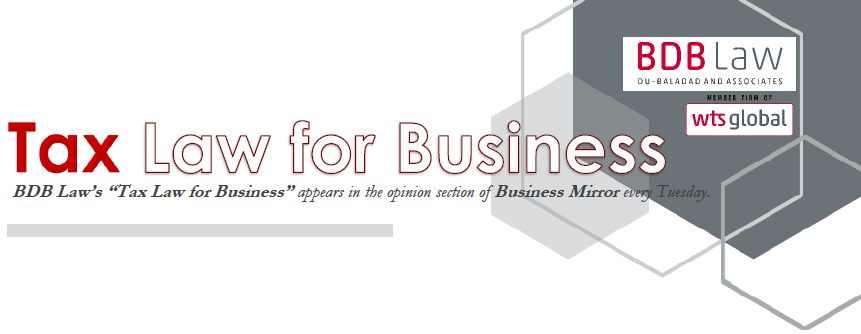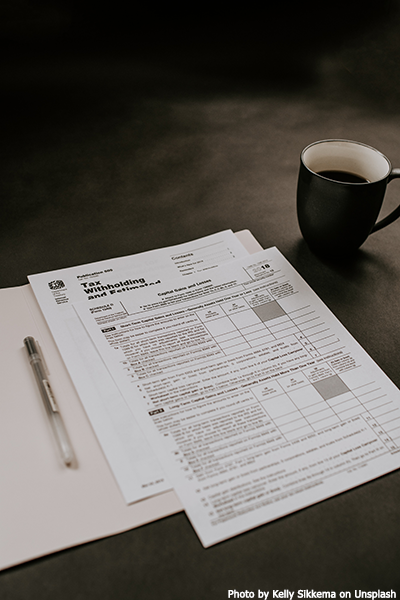
Tax Provisions Under the Bayanihan to Recover as One Act
By: Fulvio D. Dawilan
"In essence, losses incurred by taxpayers for the years 2020 to 2021 may be carried over as deductions by the same taxpayer within next three taxable years, following the usual rules on carry-over. If the loss is not utilized or fully utilized as deduction within that three-year period, the taxpayer may still utilize the same within the next two taxable years."
The Bayanihan to Recover as One Act (“Bayanihan 2”) was passed to strengthen the government's efforts in mitigating the effects of COVID-19. Among the response and recovery interventions provided in the act are tax reliefs that would somehow help ease the burdens of taxpayers. There are also exemptions from tax effects of some of these interventions which would otherwise be imposed under normal circumstances. And there are incentives granted to specific transactions. I will discuss two of these tax provisions.
First is on the carry-over of net operating loss carry-over (“NOLCO”) to the succeeding years. Ordinarily, the NOLCO can be carried over to the next three (3) consecutive taxable years immediately following the year of such loss. As part of mitigating the costs and losses stemming from the disruption of economic activities, Bayanihan 2 extends the carry-over of the NOLCO as deductions to the next succeeding five (5) consecutive taxable years immediately following the year of the loss.
 Note that this extended carry-over shall pertain only to the net losses incurred by businesses or enterprises for the taxable years 2020 and 2021. As defined by Revenue Regulations 25-2020 (RR 25-2020), a taxable year shall be understood to mean the calendar year or the fiscal year ending during such calendar year, upon the basis of which the taxable net income is computed by the concerned taxpayer.
Note that this extended carry-over shall pertain only to the net losses incurred by businesses or enterprises for the taxable years 2020 and 2021. As defined by Revenue Regulations 25-2020 (RR 25-2020), a taxable year shall be understood to mean the calendar year or the fiscal year ending during such calendar year, upon the basis of which the taxable net income is computed by the concerned taxpayer.
The five-year carry-over should therefore cover losses sustained by taxpayers using the calendar years ending on December 31, 2020 and December 31, 2021. Likewise, taxpayers whose fiscal years falling within said periods are covered. As clarified by RR 25-2020, the fiscal years 2020 and 2021 shall include all those corporations with fiscal years ending on or before June 30,2021 and June 30, 2022, respectively. Thus, losses incurred by taxpayers using fiscal year ending on June 30, 2021 can be carried over to the next five years. The same applies to losses incurred by taxpayers whose fiscal years will end on June 30, 2022. Similarly, taxpayers using fiscal years in between these dates are allowed the same period of carry-over.
The taxable year entitled to the five-year NOLCO carry-over likewise includes a fractional part of a year, in case a return is made for such period. For instance, a taxpayer who changes its taxable year is required to file a short period return. I believe the loss incurred in that part of a year, provided that period falls within the taxable years 2020 and 2021, shall be allowed to be carried over to the next five years.
In essence, losses incurred by taxpayers for the years 2020 to 2021 may be carried over as deductions by the same taxpayer within next three taxable years, following the usual rules on carry-over. If the loss is not utilized or fully utilized as deduction within that three-year period, the taxpayer may still utilize the same within the next two taxable years.
Another tax provision in the Bayanihan 2 relates to the one-time sixty (60)-day grace period to be granted for the payment of all existing, current and outstanding loans falling due, or any part thereof, on or before December 31, 2020, and thereby extending the maturity of the said loans.
Ordinarily, any alteration of any evidence of obligation or indebtedness, including the extension of maturity dates, are subject to another round of documentary stamp taxes. Accordingly, with the one-time 60-day grace period effectively altering the maturity period of existing loans, the extension should be subject to the documentary stamp taxes. This is, however, addressed by the Bayanihan 2 by providing that the resulting loan term extensions or restructuring arising from this requirement shall be exempt from the documentary stamp taxes. This exemption is made clearer by the implementing regulations (RR 24-2020), which provides that no additional DST shall apply to term extensions and credit restructuring, micro-lending including those obtained from-pawnshops and extensions thereof granted by covered institutions for loans falling due, or any part thereof, on or before December 31,2020. Thus, while extensions or restructuring of loans may necessarily result from the grant of grace period in the payment of amounts due, the DST shall not accrue on the extended or restructured loans.
Compared to similar exemption provided in Bayanihan 1, the coverage and the implementation of the DST exemption under Bayanihan 2 is more straightforward. And I hope the tax authority will do away with the requirement for submission of certain reports as prescribed in the implementing rules of Bayanihan 1. The law does not require such submission, and so creditors should not be penalized for non-compliance with a requirement that is not provided in the law.
Aside from these two, there are other tax exemption/incentive provisions provided in the Bayanihan 2, such as the exemption of compensation provided to public and private health workers who contract the COVID-19 disease in the line of duty, incentives on the manufacture and importation of certain critical equipment, among others. I hope the tax authority will also provide implementing rules on these matters for the guidance of those concerned.
The author is the Managing Partner of Du-Baladad and Associates Law Offices (BDB Law), a member-firm of WTS Global.
The article is for general information only and is not intended, nor should be construed as a substitute for tax, legal or financial advice on any specific matter. Applicability of this article to any actual or particular tax or legal issue should be supported therefore by a professional study or advice. If you have any comments or questions concerning the article, you may e-mail the author at This email address is being protected from spambots. You need JavaScript enabled to view it. or call 8403-2001 loc 310.




